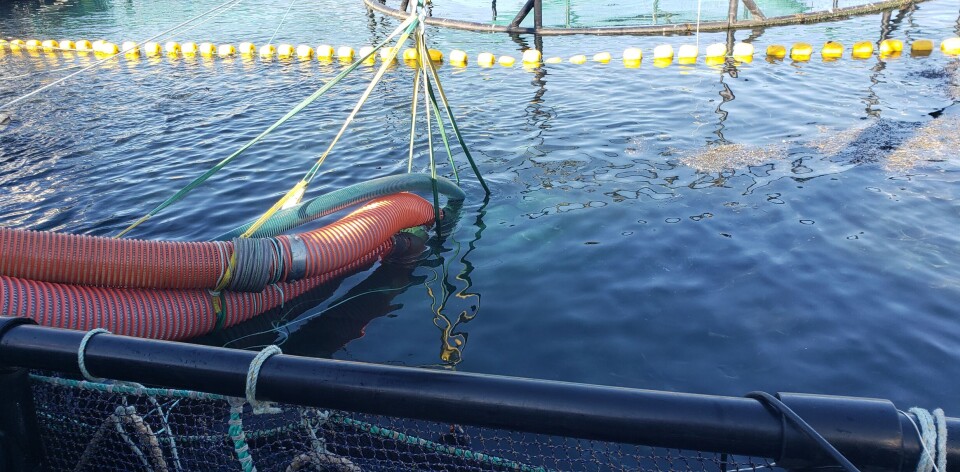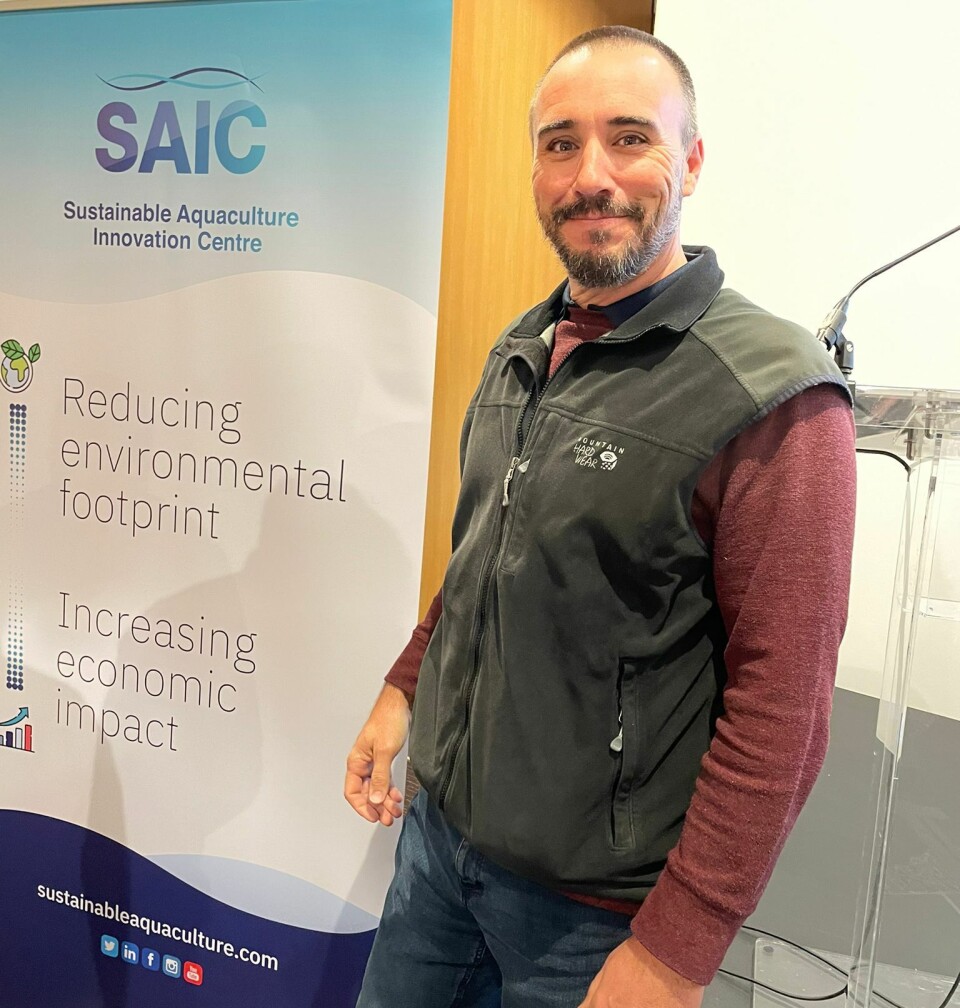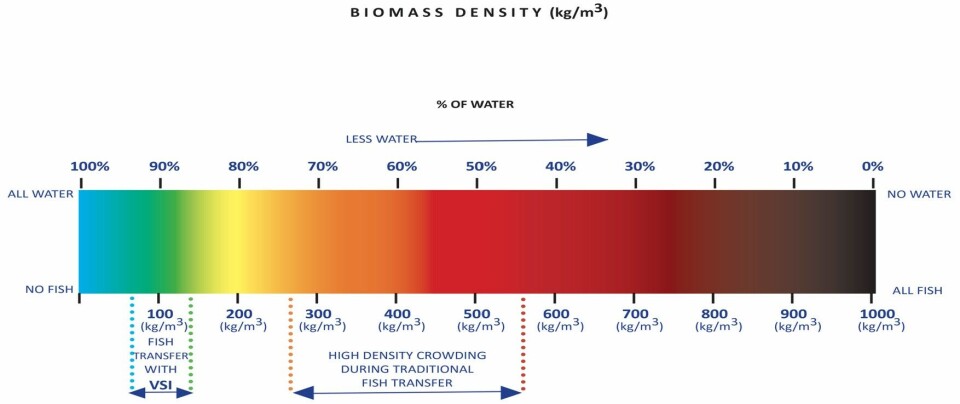
Cooke Scotland seeks to step away from the crowd
Fish farmer will trial a new system that avoids putting the squeeze on salmon
A Canadian company that has developed an alternative to the “crowding” of farmed fish for transfer to wellboats for treatment or transfer will carry out sea trials of its technology in Scotland this summer.
East Coast Innovation (ECI), based in St Andrews, New Brunswick, is led by Joel Halse, who spent more than a decade as a corporate engineer for salmon farmer Cooke Aquaculture Inc., in Atlantic Canada, and it is Cooke’s Scottish operation in Orkney and Shetland that is collaborating in the trials.
Crowding uses a net to reduce the area fish have in a pen and is used to move fish close to a hose that sucks them aboard a wellboat. It is one of the factors that can stress farmed salmon, which can lead to mortalities, disease transfer, and loss of appetite.
Voluntary Swim-In
ECI has developed a patented system called the Voluntary Swim-In, or VSI, which it says changes the conditions in front of the fish pump so that fish naturally move into the transfer system without crowding.
Based on our live fish laboratory trials, we know that the VSI allows for a more consistent transfer rate while maintaining low biomass density in the waiting fish population
ECI communications chief Nell van Wyngaarden
“The exact nature of these conditions and water flow patterns, are based on our observance of fish behaviour and form the foundation of our patent so we are not able to give the exact details of how it works,” the company’s vice president communications, Nell van Wyngaarden, told Fish Farming Expert.
“We can tell you that, based on our live fish laboratory trials, we know that the VSI allows for a more consistent transfer rate while maintaining low biomass density in the waiting fish population, with lots of water for every animal waiting its turn to go through the fish pump.
“This means that the fish are less stressed and eat shortly after transfer. The result is better survivability, better health outcomes and more feeding days.”
'Where the fish want to be'
Speaking at a summit organised by Scotland’s Sustainable Aquaculture Innovation Centre (SAIC) in Glasgow in May, ECI’s chief commercial officer John Pennell said the challenge of transferring salmon from cage to cage and cage to vessel costs the industry billions of dollars a year globally, and that it was clear from observation that salmon don’t like the “scary, dark hoses” they are crowded into.

“The Voluntary Swim-In moves the transfer zone down to where the fish want to be. Salmon like to be in the cooler, deeper water, not up at the top which is where fish farmers have to raise the fish up to so they can transfer them with the current system,” he told the summit.
“The VSI attracts the fish to the transfer zone, and we do that by creating an environment that salmon like. And we can do this at a low biomass density: that’s the key, we believe, to improving fish welfare and the outcomes that we’re hoping to see.”
ECI has been lab testing a small-scale VSI at its live fish testing facility at the Huntsman Marine Science Centre in Saint Andrews, New Brunswick.
Weekly transfers
“We transfer a population of fish once a week from tank to tank. We monitor fish welfare, transfer rates, improvement for our VSI,” said Pennell.
“We have been able to prove that our technology works, that salmon like what we’ve created, and we’ve been able to show that the fish return to feed within an hour post-transfer, which is a significant improvement over [today’s use of crowding] where currently it can be potentially days before the fish start to eat again.
“That means the fish aren’t as stressed, that we’re going to have higher biomass gains, and we’re going to see fewer mortalities, and the economic impact of that is significant. We’re looking forward to starting the gather this data.”
As well as trials at the Huntsman and the planned trials in Scotland, ECI is also conducting sea trials in New Brunswick as it continues to develop its technology.
Cortisol measurements
The sea trials with Cooke Aquaculture Scotland will also involve WellFish Diagnostics, which is based at the University of the West of Scotland in Paisley, which will monitor fish stress levels by measuring their production of the stress hormone, cortisol.
“We are very excited about the opportunity to pursue the commercialisation of the VSI in Scotland with sea trials scheduled to begin in partnership with Cooke Aquaculture Scotland this summer,” said Wyngaarden.
“The purpose of this project is to measure the improvement of fish welfare. To accomplish this, we will evaluate cortisol levels of the fish, with support from WellFish Diagnostics. We will observe how quickly the fish return to feed as well as other welfare indicators. In addition, we are exploring other partnerships in Scotland.”
Culture of innovation
“At Cooke, we have a culture of innovation, and the health and welfare of our farm-raised salmon is a top priority. We are committed to using best management practices and equipment that support the well-being of our salmon,” said Joel Richardson, vice president of public relations for Cooke Inc.
“It’s important that we embrace emerging technologies like VSI from East Coast Innovation that aim to enhance the care and handling of our salmon. In any given year across our farmed and wild fishery divisions, we trial many new techniques to ensure our seafood products are reared and harvested in a healthy environment.”

In his presentation at the SAIC summit, ECI’s Pennell said crowding delivered spikes of volume that decreased the operational efficiency of equipment aboard a wellboat, whereas trials at the Huntsman facility demonstrated a “nice, smooth, consistent amount of fish that are being transferred”.
Crowding also pushes fish into what ECI calls a danger zone (see graphic, above) where densities can compromise fish welfare.
“Currently we (the salmon industry) are transferring from 250 kilos per cubic metre up to 550 kilos per cubic metre or more (using crowding). With the VSI we’re able to transfer those same fish between 75 and 125 kilos per cubic metre or less,” said Pennell.
“We talk about that blue-green zone as the safe zone, and when you’re in that safe zone you’re monitoring the water, oxygen level, PH level, temperature. When you’re in that orange-red-black zone – we call it the danger zone – you are monitoring a lot more significantly different things at that point.
“With the VSI we’re no longer putting the fish in a challenging situation.”






















































